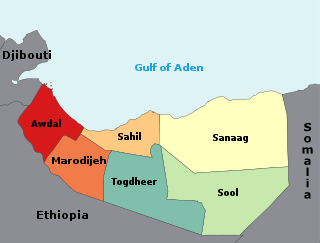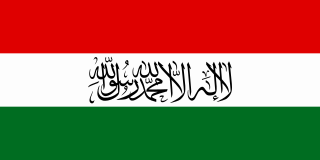Related Research Articles

French Somaliland was a French colony in the Horn of Africa. It existed between 1884 and 1967, at which time it became the French Territory of the Afars and the Issas, after the French empowered the Issa and Afars at the expense of the Gadabuursi and Arabs. The Republic of Djibouti is its legal successor state.

Ogaden is one of the historical names used for the modern Somali Region which forms the eastern portion of Ethiopia and which borders Somalia. Before 1995 most of Ogaden was part of Ethopia's Hararghe province. The other names sometimes used for this area are Haud or Hawd.

Greater Somalia is an irredentist concept to unite all ethnic Somalis comprising the regions in or near the Horn of Africa in which ethnic Somalis live and have historically inhabited. The territory historically encompassed British Jubaland Province, British Somaliland, Italian Somaliland, parts of French Somaliland, the Somali Region in Ethiopia, the Northern Frontier District in Kenya, and the intra-46th meridian east territories. At the present, it encompasses Somalia proper, Jubaland, southern and eastern Djibouti, the Somali Region, Harar, and Dire Dawa in Ethiopia, and the Garissa, Wajir and Mandera Counties in Kenya. A few sources even included the islands of Socotra, Abd al Kuri, Samhah, Darsah, Sabuniyah and the Ka'l Fir'awn islands in Yemen's Socotra Archipelago.

Dire Dawa is a city in eastern Ethiopia near the Oromia and Somali Region border and one of two chartered cities in Ethiopia. Dire Dawa alongside present-day Sitti Zone were a part of the Dire Dawa autonomous region stipulated in the 1987 Ethiopian Constitution until 1993 when it was split by the federal government into a separately administered chartered city.

Mohammad Ali Samatar. was a very senior Somali National hero, Revolutionary, Military Officer, Communist, Politician, former Commander-in-Chief of the Somali National Army, former Minister of Defence, former Vice President, former Deputy General Secretary of the Somali Revolutionary Socialist Party, former Prime Minister, a leading figure and the second most powerful man in the Somali Democratic Republic after president Mohamed Siad Barre. He's the only officer who has ever reached the rank of Lieutenant General in the history of the Somali Armed Forces. He was known for his intelligent military tactics in the 1964 Ethiopian–Somali Border War, Ogaden War and 1982 Ethiopian–Somali Border War. He's regarded as one of the greatest military officers of the African continent.
The Dir is one of the largest and most prominent Somali clans in the Horn of Africa. They are also considered to be the oldest Somali stock to have inhabited the region. Its members inhabit Djibouti, Somalia, Ethiopia, and northeastern Kenya.

The regions of Somaliland is divided into six administrative regions, Awdal, Sahil, Maroodi-Jeeh, Togdheer, Sanaag and Sool. These are in turn subdivided into twenty-two districts. Regions of Somaliland are the primary geographical divisions through which Somaliland is administered. A distinction is made between districts of grades A, B, C and D, with the classification being based on population, area, economy and production.

The Gadabuursi, also known as Samaroon, is a northern Somali clan, a sub-division of the Dir clan family.

The Somali National Movement was one of the first and most important organized guerilla groups and Mujahideen groups that opposed to the Siad Barre regime in the 1980s to the 1990s, as well as being the main anti-government faction during the Somaliland War of Independence. The organisation was founded in London, England, on April 6, 1981 by Hassan Isse Jama, Hassan Adan Wadadid, and Ahmed Mohamed Gulaid and other former Somali diplomats, who stated that initially the group's purpose was to overthrow the Siad Barre regime.
The Somali Rebellion was the beginning of the civil war in Somalia that occurred in the 1980s and early 1990s. The rebellion started in 1978 when President Siad Barre began using his special forces, the "Red Berets", to attack clan-based dissident groups opposed to his regime. The dissidents had been becoming more powerful for nearly a decade following his abrupt switch of allegiance from the Soviet Union to the United States and the disastrous 1977-78 Ogaden War.

Hussein Kulmiye Afrah was Vice President of Somalia in the era of Siad Barre between 1972 and 1990. He was also a member of the Supreme Revolutionary Council.
Ceel Buur is a town located in the region of Galguduud in central Somalia.

Abdullah Mohamed Fadil, also known as Abdalla Mohamed Fadil, was a prominent Somali military figure.
The Gurgura, Gorgorah or Gurgure is a northern Somali clan, a sub-division of the Dir clan family.

The Isaaq genocide, also known as the Hargeisa holocaust, was the systematic, state-sponsored genocide of Isaaq civilians between 1987 and 1989 by the Somali Democratic Republic, under the dictatorship of Siad Barre, during the Somaliland War of Independence. The number of civilian deaths in this massacre is estimated to be between 50,000 and 100,000, according to various sources, whilst local reports estimate the total civilian deaths to be upwards of 200,000 Isaaq civilians. The genocide also included the levelling and complete destruction of the second and third largest cities in the Somali Republic, Hargeisa and Burao, respectively, and had caused up to 500,000 Somalis of the region, primarily of the Isaaq clan, to flee their land and cross the border to Hartasheikh in Ethiopia as refugees in what was described as "one of the fastest and largest forced movements of people recorded in Africa", which resulted in the creation of the world's largest refugee camp then (1988), with another 400,000 being displaced. The scale of destruction led to Hargeisa being known as the 'Dresden of Africa'. The killings happened during the Somali Civil War and have been referred to as a "forgotten genocide".

The Mayor of Mogadishu is head of the executive branch of Mogadishu, the capital of Somalia. The mayor's office administers all city services, public property, police and fire protection, most public agencies, and enforces laws within the city. Mayor Sheik Yousuf Hussein Jim'ale was appointed on 14 September 2022 and succeeded the Mayor Omar Mohamoud Mohamed Filish.
The Akisho is a northern Somali clan, a sub-division of the Dir clan family.
The 26th Division,, also known as the Northern Division was one of five Somali National Army divisions. The 26th was responsible for northern Somalia and was headquartered in the city of Hargeisa. In 1977, the division was responsible for the Dire Dawa front in the Ogaden War.
The Makayl-Dheere also known as Makaahiil-Dheere (Makayldheere), is a northern Somali clan, a sub-division of the Makahiil sub-clan of the Gadabuursi Dir clan family.

The Somaliland War of Independence was a rebellion waged by the Somali National Movement (SNM) against the ruling military junta in Somalia led by General Siad Barre lasting from its founding on 6 April 1981 and ended on 18 May 1991 when the SNM declared what was then northern Somalia independent as the Republic of Somaliland. The conflict served as the main theater of the larger Somali Rebellion that started in 1978. The conflict was in response to the harsh policies enacted by the Barre regime against the main clan family in Somaliland, the Isaaq, including a declaration of economic warfare on the clan-family. These harsh policies were put into effect shortly after the conclusion of the disastrous Ogaden War in 1978.
References
- ↑ Kefale, Asnake (2013-07-31). Federalism and Ethnic Conflict in Ethiopia: A Comparative Regional Study. Routledge. p. 76. ISBN 9781135017989.
- ↑ Kapteijns, Lidwien (2012-12-18). Clan Cleansing in Somalia: The Ruinous Legacy of 1991. University of Pennsylvania Press. p. 89. ISBN 978-0812207583.
- ↑ Kapteijns, Lidwien (2012-12-18). Clan Cleansing in Somalia: The Ruinous Legacy of 1991. University of Pennsylvania Press. p. 89. ISBN 978-0812207583.
- ↑ Eastern Africa Social Science Research Review. Organization for Social Science Research in Eastern Africa. 1995-01-01. p. 60.